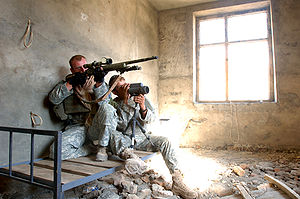This article needs additional citations for verification. Please help improve this article by adding citations to reliable sources. Unsourced material may be challenged and removed.Find sources: "Hunter-killer team" – news · newspapers · books · scholar · JSTOR (June 2019) (Learn how and when to remove this template message)

A hunter-killer team is a team that separates the tasks of "hunting" and "killing" to two or more individuals.
Examples include:
- Two-person sniper teams, one using specialized optical hardware and the other a rifle
- Pairs of F-4G Wild Weasel V and F-16Cs, where the F-4G "hunter" could detect, identify, and locate an enemy's radar and then direct the F-16C's weapons to the site
- Bradley fighting vehicles may "hand off" fire missions to M1 Abrams main battle tanks in their hunter-killer team, but Bradley’s have TOWs and can engage
- "Pink teams" of scout and attack helicopters, such as OH-6 "Loach" or OH-58 Kiowa scout helicopters and the AH-1 Cobra attack helicopter during the Vietnam War
- In anti-submarine warfare an Maritime patrol aircraft may be employed as "hunter", with surface ships such as destroyers as killers.
- Task Forces such as Task Force 88 where one element, the "hunter," (e.g., CIA Operatives) gathers intelligence on the target while the other, the "killer," (e.g., Delta Force or Rangers) acts on the intelligence and eliminates the target.